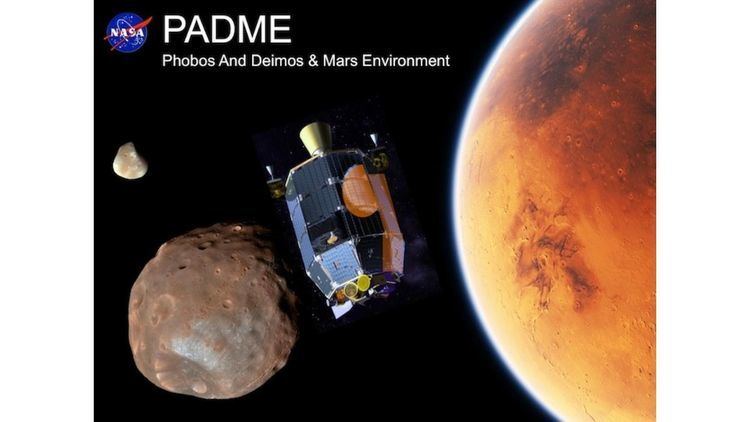Launch date Aug 2020 (proposed) Launch site Kennedy Space Center | ||
 | ||
Rockets Atlas V, Delta IV, Falcon 9 | ||
Phobos And Deimos & Mars Environment (PADME) is a proposed low-cost NASA Mars orbiter mission that would address longstanding unknowns about Mars' two moons Phobos and Deimos and their environment.
Contents
The PADME mission is competing for Discovery Program funding. The mission is led by Anthony Colaprete (Principal Investigator). Other principals include Pascal Lee (Deputy Principal Investigator) and Butler Hine (Project Manager). If selected, PADME would launch in 2020 and reach Mars orbit in 2021 and conduct multiple flybys of its moons.
Objectives
The origin of Mars' satellites, which were discovered by astronomer Asaph Hall, remains unknown. PADME would advance the scientific understanding of the origin of Phobos and Deimos by studying:
In addition, PADME would assess potential resources (water, organics, regolith) and potential hazards (dust) that Phobos and Deimos might present for future human exploration in Mars orbit.
Mission
Once in Mars orbit, PADME would carry out 16 flybys of Phobos followed by 9 flybys of Deimos. Flybys would take place at two-week intervals. Flyby altitudes at closest approach to Phobos and Deimos would be ~2 km. Following completion of its primary mission, PADME could remain in high Mars orbit for long-term monitoring of the martian system and search for potential additional moonlets around Mars. Alternatively, PADME could be made to escape Mars and eventually fly by a Near-Earth Object (NEO).
Spacecraft
NASA Ames Research Center would design, develop, build, and test the PADME spacecraft, and manage mission operations. The proposal is to employ the proven Modular Common Spacecraft Bus (MCSB), previously used by the LADEE Moon orbiter. Major partners include the SETI Institute, Jet Propulsion Laboratory, NASA Goddard Space Flight Center, and University of Colorado's Laboratory for Atmospheric and Space Physics.
Scientific payload
The PADME mission has four science instruments plus a radio science experiment which uses the spacecraft's radio communications system.
The orbiter could also carry an optional laser communications experiment.
Proposed launch
PADME could launch on a Falcon 9-class launch vehicle. The spacecraft would fit within all Atlas V, Delta IV, and Falcon 9 launch vehicle fairings. If selected, PADME would launch in August 2020 and reach Mars seven months later, by March 2021.
International Participation
PADME includes the participation of scientists from Belgium, France, Italy, and Japan.
